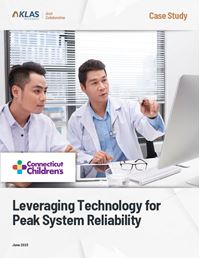

Leveraging Technology for Peak System Reliability
Connecticut Children's prioritizes system reliability through virtualization, redundancy, routine infrastructure assessments, and the monitoring of performance metrics.
Publish Date: 06/26/2023
| Cost to Implement: | $$ - Budgeted Cost |
| Time to Implement: | 0–6 months |
Program Goals
- Keep planned and unplanned EHR system downtimes to a minimum
- Reduce lag time in the EHR
Organization Outcomes
- Providers 99th percentile for agreement that EHR is reliable
- Providers 96th percentile for satisfaction with EHR response time
Collaborative-Verified Best Practices
- Technological foundation: reliability and response time
What Connecticut Children's Did
Connecticut Children's prioritizes system reliability through a highly dependable infrastructure with two active data centers and server-based computing. They use virtualization and redundancy to provide resilience and automated failover. Planned downtimes for maintenance are divided into two windows with the goal of keeping downtimes under an hour. The organization has a five-year refresh cycle for their data center equipment and routinely assesses their Wi-Fi performance and network infrastructure. They recommend practicing a daily management system and using metrics to monitor the performance of the EHR weekly, emphasizing identifying issues, and conducting a root cause analysis for troubleshooting. The organization values teamwork and listening to ideas for enhancing their processes and infrastructure.
How Connecticut Children's Did It
Access the feedback of
500,000+ clinicians worldwide
Access the feedback of
500,000+ clinicians worldwide
Here is my information:
Featured in Learning Track
Topics
Clinician Relationships & Communication, System Reliability & Response TimeReader Responsibility
These perspectives are shared to facilitate better collaboration and communication between members of the Arch Collaborative. We encourage organizations to thoughtfully adjust their current operations based on their own experience, the findings of this research, and other complementary sources of information.
Copyright Infringement Warning
This report and its contents are copyright-protected works and are intended solely for your organization. Any other organization, consultant, investment company, or vendor enabling or obtaining unauthorized access to this report will be liable for all damages associated with copyright infringement, which may include the full price of the report and/or attorney’s fees. For information regarding your specific obligations, please refer to the KLAS Data Use Policy.

Arch Collaborative Mission
Unlock the potential of EMR solutions to revolutionize healthcare efficiency and care-quality improvements by facilitating collaboration, measurement, and shared learning.
The Arch Collaborative is committed to finding and sharing healthcare technology best practices that forward the efforts of the quadruple aim in healthcare. The engine of the Arch Collaborative is the insights and feedback of thousands of clinicians and caregivers around the world.
Learn more about the Arch Collaborative: https://klasresearch.com/arch-collaborative
The Arch Collaborative is a service of KLAS Research: klasresearch.com
About Arch Collaborative Case Studies
Arch Collaborative case studies are focused on highlighting success that Collaborative participants achieve with or through healthcare technology. They are meant to briefly advertise member success and act as starting points for ongoing communication and collaboration between member organizations.
Case studies are typically published when (1) a verified outcome is recorded (and often verified through the Collaborative survey) and (2) the approach or steps to achieving that outcome aren’t commonly known and would be helpful to other organizations.
All Collaborative members and participants are invited to submit case studies by working with their KLAS guide.
All case studies can be viewed at: https://klasresearch.com/learningcenter/casestudies
 |
KLAS | ® |


